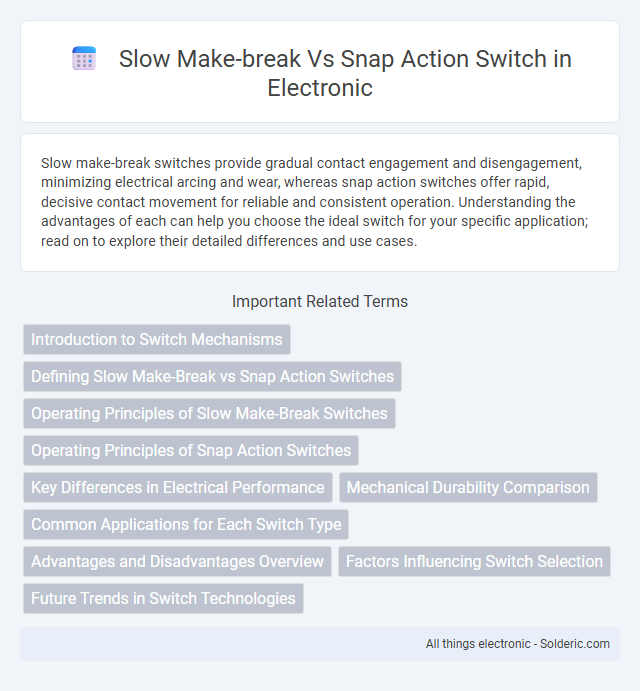Slow make-break switches provide gradual contact engagement and disengagement, minimizing electrical arcing and wear, whereas snap action switches offer rapid, decisive contact movement for reliable and consistent operation. Understanding the advantages of each can help you choose the ideal switch for your specific application; read on to explore their detailed differences and use cases.
Comparison Table
| Feature | Slow Make-Break Switch | Snap Action Switch |
|---|---|---|
| Contact Operation | Gradual opening and closing | Instantaneous opening and closing |
| Contact Speed | Slow and controlled | Rapid, high-speed |
| Contact Bounce | Higher contact bounce risk | Minimal contact bounce |
| Wear and Tear | Increased due to arcing and contact wear | Reduced wear due to quick operation |
| Applications | Simple manual switches, volume controls | Limit switches, safety devices, relays |
| Reliability | Lower in high-frequency use | High reliability under frequent operation |
| Cost | Generally lower | Usually higher |
Introduction to Switch Mechanisms
Slow make-break switches feature gradual contact engagement and disengagement, providing precise control for applications requiring careful electrical transitions. Snap action switches utilize a spring-loaded mechanism that rapidly toggles contacts, ensuring quick and reliable operation with minimal arcing and wear. Your choice depends on the required response speed and durability in your electrical circuit design.
Defining Slow Make-Break vs Snap Action Switches
Slow make-break switches operate by gradually opening or closing electrical contacts, allowing controlled current flow changes suitable for applications requiring precise timing and minimal arcing. Snap action switches, in contrast, rapidly move contacts between open and closed states with a sudden, tactile click, ensuring reliable and fast switching in high-speed or high-frequency circuits. Understanding these operational differences is crucial for selecting the appropriate switch type in industrial controls, automotive systems, and electronic devices.
Operating Principles of Slow Make-Break Switches
Slow make-break switches operate by gradually opening or closing electrical contacts, allowing controlled current flow changes that reduce arcing and wear. Their mechanism relies on a deliberate, smooth movement, often facilitated by springs or damping components to ensure steady contact engagement or separation. This precise control suits applications where minimizing electrical noise and contact erosion is critical.
Operating Principles of Snap Action Switches
Snap action switches operate using a spring-loaded mechanism that quickly changes the contact position with a rapid, precise movement, ensuring reliable electrical connections without arcing. The sudden shift in contacts is triggered when a specific force threshold is reached, providing consistent performance and long service life. Your choice between a slow make-break and a snap action switch depends on the need for speed and accuracy in switching operations.
Key Differences in Electrical Performance
Slow make-break switches feature gradual contact separation and closing, resulting in reduced electrical arcing and smoother current transition, which is ideal for low-voltage or sensitive circuits. Snap action switches rapidly open or close contacts with a quick, decisive movement, producing higher initial contact force that minimizes contact bounce and enhances switching reliability in high-frequency or heavy load applications. The electrical performance difference centers on contact timing and arc suppression, where slow make-break excels in controlled circuit conditions and snap action ensures durability and consistency under demanding electrical loads.
Mechanical Durability Comparison
Slow make-break switches typically exhibit a longer mechanical durability due to their simple, gradual contact movement which reduces wear from abrupt impacts. Snap action switches, while providing rapid contact changes for precise control, often face higher mechanical stress resulting in a shorter lifespan under high-frequency operations. Mechanical durability in snap action switches usually ranges between 100,000 to 1,000,000 cycles, whereas slow make-break switches can exceed this under less demanding usage conditions.
Common Applications for Each Switch Type
Slow make-break switches are commonly used in dimmer controls, thermostats, and motor speed controls where gradual change is needed to prevent electrical arcing and component wear. Snap action switches are ideal for safety devices, limit switches, and control panels where rapid, reliable contact change is essential for precise operation and avoiding contact bounce. Your choice between these switch types depends on whether you require smooth transition or quick, decisive switching in your application.
Advantages and Disadvantages Overview
Slow make-break switches provide controlled contact engagement, reducing electrical arcing and wear, which enhances circuit longevity in low-speed applications. Snap action switches offer rapid contact movement that ensures reliable, consistent circuit operation and minimizes contact bounce, making them ideal for high-speed or safety-critical devices. However, slow make-break switches may suffer from slower response times and increased contact wear under rapid cycling, while snap action switches can produce mechanical noise and may be less suited for delicate or low-force applications.
Factors Influencing Switch Selection
Factors influencing switch selection include the required contact speed, electrical load, and application environment. Slow make-break switches offer controlled contact engagement ideal for circuits sensitive to inrush current, while snap action switches provide rapid contact changes to reduce arcing and wear in high-frequency operations. Your choice depends on balancing durability, electrical performance, and operational safety.
Future Trends in Switch Technologies
Future trends in switch technologies emphasize integrating smart sensor capabilities with slow make-break switches to enhance precision and durability in industrial applications. Snap action switches are evolving with improved electronic feedback mechanisms, enabling faster response times and higher reliability in automated systems. Emerging materials and miniaturization techniques aim to optimize both switch types for energy efficiency and seamless IoT connectivity.
slow make-break vs snap action switch Infographic

 solderic.com
solderic.com